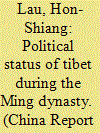| Srl | Item |
| 1 |
ID:
114901


|
|
|
|
|
| Publication |
2012.
|
| Summary/Abstract |
Much has been written about China's rise, yet from a historical perspective,
China's rise is nothing new. Historian Wang Gungwu points out three past
instances: the Qin-Han unification, the Sui-Tang reunification, and the
Ming-Qing dynasties. The present, fourth rise of China 'needs to be seen
in a longer perspective'.
1
What can we learn from China's rich historical
experience? The polity that we now know as China was the most powerful
state and a regional hegemon during certain periods of East Asian history.
How did China behave in the region when it had preponderant power? Did
China expand when strong? And how did China manage its hegemony to
stay on top? As the Ming dynasty (1368-1644) is the only period from the
fall of the Tang dynasty in 907 until the end of the Qing dynasty in 1912
when a native or non-alien Chinese dynasty dominated East Asia, this feature alone makes the Ming dynasty a good vehicle for examining Chinese
strategic behaviour. By examining a past regional hegemon, this article
offers a first-cut at the longer historical perspective on the rise of China.
|
|
|
|
|
|
|
|
|
|
|
|
|
|
|
|
| 2 |
ID:
165271


|
|
|
|
|
| Summary/Abstract |
This study analyses two authoritative texts and a map from the Ming and Qing eras to examine the political relationship between China and Tibet in the Ming period. It finds that in these documents Tibet was not classified as being a part of the realm governed by the Ming Empire. This casts doubt on the claim advanced by the People’s Republic of China that Tibet has been a part of China ‘since antiquity’. An important conclusion of this study is that, when taking recourse to historical texts to justify or refute territorial claims, the structure and content of the text as a whole, and not just isolated phrases or formulations, should be taken into account.
|
|
|
|
|
|
|
|
|
|
|
|
|
|
|
|